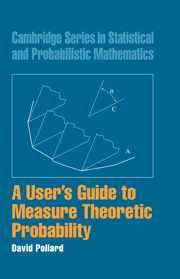Book contents
- Frontmatter
- Contents
- PREFACE
- CHAPTER 1 MOTIVATION
- CHAPTER 2 A MODICUM OF MEASURE THEORY
- CHAPTER 3 DENSITIES AND DERIVATIVES
- CHAPTER 4 PRODUCT SPACES AND INDEPENDENCE
- CHAPTER 5 CONDITIONING
- CHAPTER 6 MARTINGALE ET AL.
- CHAPTER 7 CONVERGENCE IN DISTRIBUTION
- CHAPTER 8 FOURIER TRANSFORMS
- CHAPTER 9 BROWNIAN MOTION
- CHAPTER 10 REPRESENTATIONS AND COUPLINGS
- CHAPTER 11 EXPONENTIAL TAILS AND THE LAW OF THE ITERATED LOGARITHM
- CHAPTER 12 MULTIVARIATE NORMAL DISTRIBUTIONS
- APPENDIX A MEASURES AND INTEGRALS
- APPENDIX B HILBERT SPACES
- APPENDIX C CONVEXITY
- APPENDIX D BINOMIAL AND NORMAL DISTRIBUTIONS
- APPENDIX E MARTINGALES IN CONTINUOUS TIME
- APPENDIX F DISINTEGRATION OF MEASURES
- INDEX
CHAPTER 6 - MARTINGALE ET AL.
Published online by Cambridge University Press: 29 March 2011
- Frontmatter
- Contents
- PREFACE
- CHAPTER 1 MOTIVATION
- CHAPTER 2 A MODICUM OF MEASURE THEORY
- CHAPTER 3 DENSITIES AND DERIVATIVES
- CHAPTER 4 PRODUCT SPACES AND INDEPENDENCE
- CHAPTER 5 CONDITIONING
- CHAPTER 6 MARTINGALE ET AL.
- CHAPTER 7 CONVERGENCE IN DISTRIBUTION
- CHAPTER 8 FOURIER TRANSFORMS
- CHAPTER 9 BROWNIAN MOTION
- CHAPTER 10 REPRESENTATIONS AND COUPLINGS
- CHAPTER 11 EXPONENTIAL TAILS AND THE LAW OF THE ITERATED LOGARITHM
- CHAPTER 12 MULTIVARIATE NORMAL DISTRIBUTIONS
- APPENDIX A MEASURES AND INTEGRALS
- APPENDIX B HILBERT SPACES
- APPENDIX C CONVEXITY
- APPENDIX D BINOMIAL AND NORMAL DISTRIBUTIONS
- APPENDIX E MARTINGALES IN CONTINUOUS TIME
- APPENDIX F DISINTEGRATION OF MEASURES
- INDEX
Summary
SECTION 1 gives some examples of martingales, submartingales, and supermartingales.
SECTION 2 introduces stopping times and the sigma-fields corresponding to “information available at a random time.” A most important Stopping Time Lemma is proved, extending the martingale properties to processes evaluted at stopping times.
SECTION 3 shows that positive supermartingales converge almost surely.
SECTION 4 presents a condition under which a submartingale can be written as a difference between a positive martingale and a positive supermartingale (the Krickeberg decomposition). A limit theorem for submartingales then follows.
SECTION *5 proves the Krickeberg decomposition.
SECTION *6 defines uniform integrability and shows how uniformly integrable martingales are particularly well behaved.
SECTION *7 show that martingale theory works just as well when time is reversed.
SECTION *8 uses reverse martingale theory to study exchangeable probability measures on infinite product spaces. The de Finetti representation and the Hewitt-Savage zero-one law are proved.
What are they?
The theory of martingales (and submartingales and supermartingales and other related concepts) has had a profound effect on modern probability theory. Whole branches of probability, such as stochastic calculus, rest on martingale foundations. The theory is elegant and powerful: amazing consequences flow from an innocuous assumption regarding conditional expectations. Every serious user of probability needs to know at least the rudiments of martingale theory.
A little notation goes a long way in martingale theory. A fixed probability space (Ω, ℱ, ℙ) sits in the background.
- Type
- Chapter
- Information
- A User's Guide to Measure Theoretic Probability , pp. 138 - 168Publisher: Cambridge University PressPrint publication year: 2001
- 1
- Cited by



